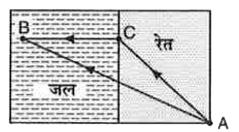समीकरण μ=sin[(A+δm)/2]sin(A/2) से μ=1.33 (जल के लिए ) और μ=1.740 (मिथाइल आयोडाइड के लिए) A=60∘ लेते हुए δm निकालें ।
हमें पता हैं कि μ=sin[(A+δm)/2]sin(A/2)
जल के लिए
1.333=sin(60∘+δm2)sin30∘
या sin(60∘+δm2)=1.33×sin30∘
=1.333×0.5000=0.6665
या (60∘+δm2)=41∘48.
या δm=23∘36.
इसी प्रकार हम मिथाइल आयोडाइड के लिए δm=61∘ निकाल सकते हैं।
Topper's Solved these Questions
- BOOK - GRB PUBLICATION HINDICHAPTER - समतल पृष्ठों पर अपवर्तनEXERCISE - प्रश्नोत्तरी(उच्चस्तरीय चिंतन )28videos
समतल पृष्ठों पर अपवर्तन
- BOOK - GRB PUBLICATION HINDICHAPTER - समतल पृष्ठों पर अपवर्तनEXERCISE - प्रश्नोत्तरी 1 अंक22videos
समतल पृष्ठों पर अपवर्तन
- BOOK - GRB PUBLICATION HINDICHAPTER - समतल पृष्ठों पर अपवर्तनEXERCISE - विषय -आधारति अभ्यास35videos
समतल पृष्ठों पर अपवर्तन
- BOOK - GRB PUBLICATION HINDICHAPTER - समतल और गोलीय पृष्ठों पर परावर्तन EXERCISE - अभ्यास14videos
समतल और गोलीय पृष्ठों पर परावर्तन
Similar Questions
बिंदु B पर चित्र एक तैराक को सहयता चाहिए। बिंदु A पर स्थित दो अलग-अलग जीवनरक्षक(lifeguards) अपने मीनार से एक ही साथ निकलते हैं परन्तु अलग -अलग मार्ग पकड़ते हैं। यद्यपि दोनों जीवनरक्षक रेत पर एक ही चाल से दौड़ते हैं और जल में एक ही चाल से तैरते हैं,फिर भी लम्बा मार्ग (ACB ) पकड़ने वाला जीवनरक्षक,A से B तक छोटा सीधा मार्ग पकड़ने वाले जीवनरक्षक से पहले बिंदु B पर पहले पहुँचता है। व्याख्या करें।
 12:17View Solution
12:17View Solutionएक ही आवृत्ति वाला प्रकाश का स्त्रोत, मछली के टैंक में जल में डुबाया जाता है| बीम, जल में टैंक के पार्श्व पर दोहरे कांच के शीशों में से ( हर काँच के शीशे का μ अलग-अलग है ) और वायु में चलती है। आम तौर पर प्रकाश के (a) आवृत्ति और (b) तरंगदैध्य्र को क्या होता है जब यह बाहर हवा में निकलती है ?
06:07View Solutionकाँच का अपवर्तनांक 1.5 और जल का 1.3 है। यदि जल में प्रकाश की चाल 2.25×108m/s, हो, तो काँच में प्रकाश की चाल क्या है ?
02:11View Solutionकिसी कमरे की दीवार पर लगे समतल दर्पण का न्यूनतम साइज़ निकालें जिससे कमरे के बीचों - बीच खड़ा कोई व्यक्ति अपने पीछे की दीवार का पूरा प्रतिबिम्ब देख सके।
01:25View Solutionसूत्र μ=sin(A+δm2)sin(A2) का निगमन कीजिये| यहाँ μ प्रिज्म के पदार्थ का अपवर्तनांक ,A प्रिज्म का कोण तथा δm अल्पतम विचलन कोण है।
04:05View SolutionA ray of light incident on one face of prism of angle 'A' with refractive index mu .There is no emergent ray if (A) mu>sin((A)/(2)) (B) (B) mu>cos ec((A)/(2)) mu>cos((A)/(2)) (D) mu=sin((A)/(2))
01:47View SolutionA ray of light incident on one face of prism of angle 'A' with refractive index mu .There is no emergent ray if (A) mu>sin((A)/(2)) (B) mu>cos ec((A)/(2)) (C) mu>cos((A)/(2)) (D) mu=sin((A)/(2))
04:05View SolutionAssertion : Refractive index of material of a prism depends on angle of prism A and angle of minimum deviation δm.
Reason : Because μ=sin(A+δm)2sinA/404:05View Solutionλ और μ के जिस मान के लिए सदिश a=2ˆi+λˆj−ˆk , सदिश b=3ˆi+ˆj−μˆkके लम्ब है तथा |a|=|b| है , वः मान है
04:05View Solutionकथन : किसी प्रिज्म के पदार्थ का अपवर्तनांक, प्रिज्म कोण A एवं न्यूनतम विचलन कोण δm पर निर्भर करता है
कारण : क्योंकि μ=sin(A+δm2)sin(A/4)View SolutionFor any prism, prove that .n. or μ=sin(A+δm2)sin(A2) where the terms have their usual meaning
03:15View SolutionFor any prism, prove that .n. or μ=sin(A+δm2)sin(A2) where the terms have their usual meaning
View SolutionFor any prism, prove that .n. or μ=sin(A+δm2)sin(A2) where the terms have their usual meaning
View SolutionDraw a graph to show variation of angle of deviation with that of angle of incidence i for a monochromatic ray of light passing through a glass prism of reflecting angle A. Hence sine deduce the relation μ=sin(A+δm)sinA/2.
Or
What is meant by dispersion of light? Prove that for a prism μ=sin(A+δm)sinA/2, where the symbols have their usual meanings.
Or
Derive the relation, μ=sin(A+δm)sinA/2, when refraction of light takes place through a glass prism. Here every letter has its usual meaning.View SolutionIf '+' stands for'+', '-' stands for '=', 'x' stands for '+', '+' stands for greater than, '=' stands for less then, '>' stands for multiplication and '<' stands for subtraction, then which of the following alternatives is correct?
View Solution

